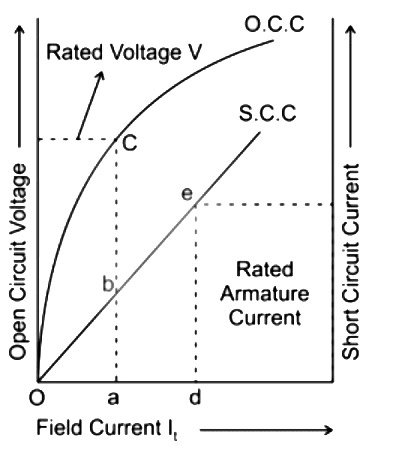In a synchronous motor if the saturation is neglected, then the short circuit ratio (SCR) will be related to the synchronous reactance (xd) as
Right Answer is:
SCR = 1/ (xd)
SOLUTION
In a synchronous motor if the saturation is neglected, then the short circuit ratio (SCR) will be related to the synchronous reactance (Xd) as SCR = 1/ (xd).
Short Circuit Test
In the short circuit test of the synchronous machine, the armature terminals are short-circuited through suitable ammeters and the field current is set at zero. While the synchronous machine is driven at synchronous speed, its armature current Ia is measured as the field current gradually increases until the armature current is about 150% of the rated current. The plot of the average armature current, versus the field current If, gives the short-circuit characteristic (SCC) of the machine. The SCC is a linear line since the magnetic-circuit iron is unsaturated.”

Synchronous Reactance
A synchronous machine can be represented as an emf source in series with the internal impedance of the machine. The internal impedance, Zs is called synchronous impedance. The synchronous reactance takes into account the effect of armature reactions and the flux produced by the armature current.
The ratio of phase voltage obtained in the open-circuit test, to the phase current, obtain in the short circuit test determines the synchronous impedance per phase.
${Z_s} = \frac{{{V_{OC}}{._{Phase}}}}{{{I_{SC.Phase}}}}$
Short circuit Ratio
The short-circuit ratio of a synchronous machine is the ratio of field current required to produce a rated voltage on the open circuit to the field current required to produce the rated armature current with the armature terminals shorted when the machine is being run mechanically at synchronous speed.

It is also equal to the reciprocal of the pu synchronous reactance, i.e.
SCR = 1/Xpu
The short circuit ratio is a measure of the alternator’s sensitivity to load changes. Machines with higher SCRs are larger in size, weigh more, and also cost more. Their voltage regulation is smaller than those of machines with smaller SCRs. Conversely, alternators with lower SCRs have larger synchronous reactances and higher voltage regulations. Hence, they require quick-acting field control devices to maintain the fairly constant output voltage.
A synchronous machine with the high value of SCR had a better voltage regulation and improved steady-state stability limit, but the short circuit fault current in the armature is high.
